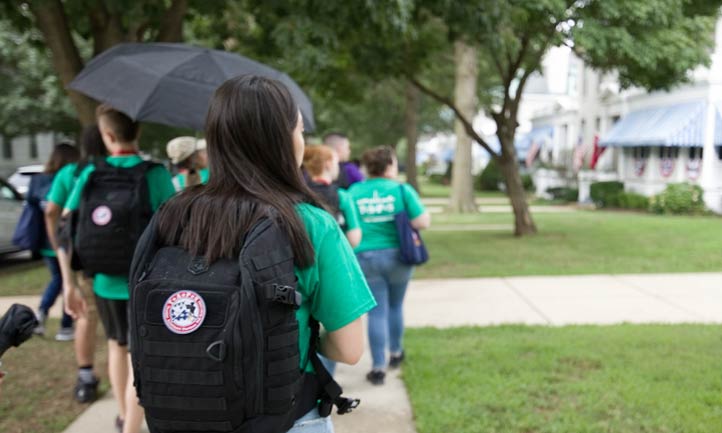Helping Surviving Families Achieve Their Post-Secondary Goals
Author: TAPS
When considering post-secondary education, begin with the end in mind and know where you would like to be in the future. It is okay to start right where you are, recognizing that every survivor is at a different point in their school search process. Take one step at a time to be closer to where you would like to be. Remember to cast a wide net when starting your search, keeping an open mind. Know that there will be many opportunities to shorten your list, but you should not limit yourself in the early stages.
As you work to create a more curated list of schools you intend to connect with and eventually apply to, be sure to determine which factors are most important to you - which priorities are non-negotiable versus which are not deal breakers. Knowing this going into your search will help focus your decision making.


1. There are Resources Available for College Entrance Exams
The eKnowledge Scholastic Aptitude Test (SAT) and American College Test (ACT) Prep Program was recently selected by the National Federation of High Schools (NFHS) as their official SAT and ACT Prep course for all 19,500 member high schools and 12 million students. The participant only pays a nominal student-fee to offset some of the program’s streaming and support expenses.
The Children of Fallen Patriots Foundation may assist with the SAT and ACT test application fees for the surviving children of military personnel who have been killed in the line of duty or from a service connected disability. They also may help with Advance Placement (AP) exams and other expenses.
2. Choosing a School
Knowing what you don't want is just as important as what you do want.
What do you want to do as a career? What program of study aligns with the career path you are pursuing? What if you don't know? Some students have known since birth they want to be a pilot, teacher, or doctor. Some students have no clue. Most students do not know for certain. With endless career options and thousands of programs of study, eliminating the "no's" is a good place to start.
Comparing schools side by side will help you choose the "right fit" school for you. Consider things such as test scores and academics, degrees offered, campus atmosphere and extracurricular activities, tuition rates, acceptance, retention and graduation rates, alumni programs, etc. Research and visit schools when in session, as your perspective may change once on campus for your initial visit. The Department of Veterans Affairs (VA) also offers the GI Bill Comparison Tool so that students can identify how much the GI Bill pays at each school, what is the Basic Allowance for Housing (BAH), on campus veteran programs and support available, and more.
3. Submit the Free Application for Federal Student Aid (FAFSA)
Before each academic year, students should file the FAFSA to determine their eligibility for federal student aid, which is typically income/need-based. Based on the information provided in the FAFSA, students may be eligible for the Federal Pell Grant, Iraq and Afghanistan Service Grant, the Federal Supplemental Educational Opportunity Grant, or other forms of financial aid. It is also important to note that many state waivers and private scholarships require the FAFSA to be completed and submitted before applying for the additional funding.
4. Start Applying for Scholarships Early
Although survivors typically cannot apply for education benefits through the VA until they are 18 years old or have graduated from high school, many scholarships open their applications early - often between January 1 and April 1. Students who wait until they are enrolled and attending a post-secondary institution have often missed most application deadlines for the upcoming school year.
To learn how much financial aid you may be eligible for, refer to the TAPS Education Portal. Keep a calendar or checklist to help manage the various private scholarships, noting they have different eligibility requirements and application deadlines.
5. Maximize your Benefits and Scholarships
TAPS aims to guide you on how to maximize benefits and scholarships. 47 out of 50 states provide some version of an education waiver for eligible survivors for undergraduate studies. Many states allow students to access the waiver before they use VA education benefits or to compliment the VA education benefits related to unmet tuition needs.
6. Submit your application for the Certificate of Eligibility (COE)
Federal education benefits specifically related to your loved one's military service are offered through the VA, with eligibility being dependent upon line of duty and/or service connection factors. Students who are 18 years old or have graduated from high school may complete and submit the VA Form 22-5490 - Dependents’ Application for VA Education Benefits in order to receive a Certificate of Eligibility from the VA. Keep in mind, this form can take an average of 3-5 weeks to process.
TAPS Education Support Services
If you or your child are exploring post-secondary education opportunities, TAPS Education Support Services is at the ready to help you navigate the process, all with a goal of helping you maximize your benefit and scholarship opportunities. To connect with a member of the TAPS Education Support Services Team, email education@taps.org or call 800.959.TAPS (8277).
